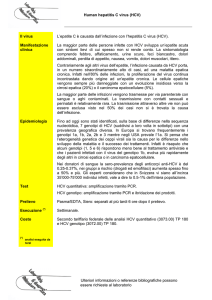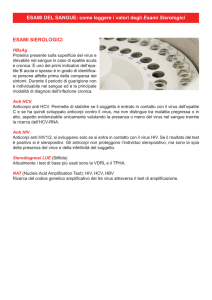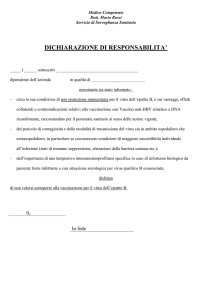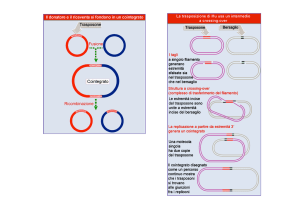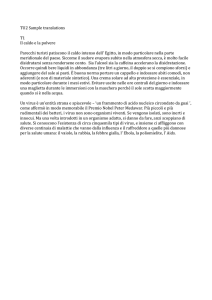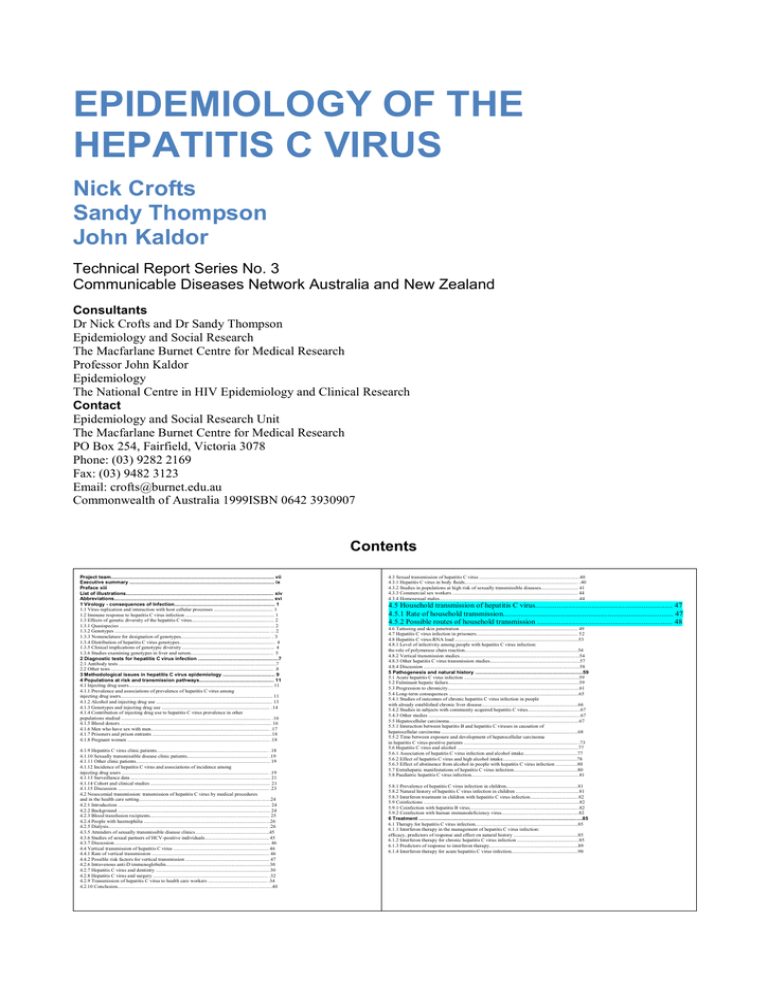
EPIDEMIOLOGY OF THE
HEPATITIS C VIRUS
Nick Crofts
Sandy Thompson
John Kaldor
Technical Report Series No. 3
Communicable Diseases Network Australia and New Zealand
ii
Consultants
Dr Nick Crofts and Dr Sandy Thompson
Epidemiology and Social Research
The Macfarlane Burnet Centre for Medical Research
Professor John Kaldor
Epidemiology
The National Centre in HIV Epidemiology and Clinical Research
Contact
Epidemiology and Social Research Unit
The Macfarlane Burnet Centre for Medical Research
PO Box 254, Fairfield, Victoria 3078
Phone: (03) 9282 2169
Fax: (03) 9482 3123
Email: [email protected]
Commonwealth of Australia 1999ISBN 0642 3930907
Contents
Project team.................................................................................................................. vii
Executive summary ..................................................................................................... ix
Preface xiii
List of illustrations....................................................................................................... xiv
Abbreviations............................................................................................................... xvi
1 Virology - consequences of Infection...................................................................... 1
1.1 Virus replication and interaction with host cellular processes .............................................. 1
1.2 Immune response to hepatitis C virus infection ..................................................................... 1
1.3 Effects of genetic diversity of the hepatitis C virus................................................................ 2
1.3.1 Quasispecies ........................................................................................................................ 2
1.3.2 Genotypes ........................................................................................................................ ... 2
1.3.3 Nomenclature for designation of genotypes...................................................................... . 3
1.3.4 Distribution of hepatitis C virus genotypes.......................................................................... 4
1.3.5 Clinical implications of genotypic diversity ....................................................................... 4
1.3.6 Studies examining genotypes in liver and serum................................................................ 5
2 Diagnostic tests for hepatitis C virus infection ........................................................7
2.1 Antibody tests ..........................................................................................................................7
2.2 Other tests .............................................................................................................................. .8
3 Methodological issues in hepatitis C virus epidemiology .................................... 9
4 Populations at risk and transmission pathways.................................................... 11
4.1 Injecting drug users..................................................................................................... ........... 11
4.1.1 Prevalence and associations of prevalence of hepatitis C virus among
injecting drug users...................................................................................................................... 11
4.1.2 Alcohol and injecting drug use .......................................................................................... 13
4.1.3 Genotypes and injecting drug use .................................................................................... .14
4.1.4 Contribution of injecting drug use to hepatitis C virus prevalence in other
populations studied .................................................................................................................... .16
4.1.5 Blood donors ..................................................................................................................... 16
4.1.6 Men who have sex with men............................................................................................ .17
4.1.7 Prisoners and prison entrants .............................................................................................18
4.1.8 Pregnant women ........................................................................................................ ...... .18
iv
4.1.9 Hepatitis C virus clinic patients....................................................................................... .18
4.1.10 Sexually transmissible disease clinic patients............................................................... .19
4.1.11 Other clinic patients........................................................................................................ 19
4.1.12 Incidence of hepatitis C virus and associations of incidence among
injecting drug users .................................................................................................................. .19
4.1.13 Surveillance data ............................................................................................................ 21
4.1.14 Cohort and clinical studies ............................................................................................. 21
4.1.15 Discussion ..................................................................................................................... .23
4.2 Nosocomial transmission: transmission of hepatitis C virus by medical procedures
and in the health care setting......................................................................................................24
4.2.1 Introduction ...................................................................................................................... 24
4.2.2 Background ...................................................................................................................... 24
4.2.3 Blood transfusion recipients............................................................................................. 25
4.2.4 People with haemophilia ............................................................................................... ...26
4.2.5 Dialysis............................................................................................................................ .26
4.3.5 Attenders of sexually transmissible disease clinics .........................................................45
4.3.6 Studies of sexual partners of HCV-positive individuals.................................................. 45
4.3.7 Discussion ............................................................................................................ ............ 46
4.4 Vertical transmission of hepatitis C virus .......................................................................... 46
4.4.1 Rate of vertical transmission ........................................................................................... 46
4.4.2 Possible risk factors for vertical transmission ................................................................. 47
4.2.6 Intravenous anti-D immunoglobulin.................................................................................30
4.2.7 Hepatitis C virus and dentistry .........................................................................................30
4.2.8 Hepatitis C virus and surgery ......................................................................................... .32
4.2.9 Transmission of hepatitis C virus to health care workers .............................................. .34
4.2.10 Conclusion........................................................................................................................40
4.3 Sexual transmission of hepatitis C virus ..............................................................................40
4.3.1 Hepatitis C virus in body fluids........................................................................................ .40
4.3.2 Studies in populations at high risk of sexually transmissible diseases............................. 41
4.3.3 Commercial sex workers ................................................................................................. 44
4.3.4 Homosexual males.............................................................................................................44
4.5 Household transmission of hepatitis C virus....................................................................... 47
4.5.1 Rate of household transmission........................................................................................ 47
4.5.2 Possible routes of household transmission ...................................................................... 48
4.6 Tattooing and skin penetration ........................................................................................... 49
4.7 Hepatitis C virus infection in prisoners............................................................................... 52v
4.8 Hepatitis C virus-RNA load ................................................................................................53
4.8.1 Level of infectivity among people with hepatitis C virus infection:
the role of polymerase chain reaction........................................................................................54
4.8.2 Vertical transmission studies.............................................................................................54
4.8.3 Other hepatitis C virus transmission studies......................................................................57
4.8.4 Discussion .........................................................................................................................58
5 Pathogenesis and natural history ...........................................................................59
5.1 Acute hepatitis C virus infection .........................................................................................59
5.2 Fulminant hepatic failure......................................................................................................59
5.3 Progression to chronicity......................................................................................................61
5.4 Long-term consequences .....................................................................................................65
5.4.1 Studies of outcomes of chronic hepatitis C virus infection in people
with already established chronic liver disease...........................................................................66
5.4.2 Studies in subjects with community acquired hepatitis C virus.........................................67
5.4.3 Other studies ......................................................................................................................67
5.5 Hepatocellular carcinoma.....................................................................................................67
5.5.1 Interaction between hepatitis B and hepatitis C viruses in causation of
hepatocellular carcinoma ..........................................................................................................68
5.5.2 Time between exposure and development of hepatocellular carcinoma
in hepatitis C virus-positive patients ..........................................................................................73
5.6 Hepatitis C virus and alcohol ..............................................................................................77
5.6.1 Association of hepatitis C virus infection and alcohol intake..........................................77
5.6.2 Effect of hepatitis C virus and high alcohol intake..........................................................78
5.6.3 Effect of abstinence from alcohol in people with hepatitis C virus infection .................80
5.7 Extrahepatic manifestations of hepatitis C virus infection..................................................80
5.8 Paediatric hepatitis C virus infection....................................................................................81
5.8.1 Prevalence of hepatitis C virus infection in children........................................................81
5.8.2 Natural history of hepatitis C virus infection in children .................................................81
5.8.3 Interferon treatment in children with hepatitis C virus infection......................................82
5.9 Coinfections .........................................................................................................................82
5.9.1 Coinfection with hepatitis B virus.....................................................................................82
5.9.2 Coinfection with human immunodeficiency virus............................................................82
6 Treatment ..................................................................................................................85
6.1 Therapy for hepatitis C virus infection................................................................................85
6.1.1 Interferon therapy in the management of hepatitis C virus infection:
efficacy, predictors of response and effect on natural history ..................................................85
6.1.2 Interferon therapy for chronic hepatitis C virus infection ................................................85
6.1.3 Predictors of response to interferon therapy.....................................................................89
6.1.4 Interferon therapy for acute hepatitis C virus infection....................................................90
4.5 Household transmission of hepatitis C virus
The existence of nonparenteral routes of transmission of HCV has been suggested because of the relatively high
proportion of people infected with HCV who have no identifiable parenteral risk factors. For example, of 342
consecutive anti-HCV-positive patients presenting to a liver clinic at a major Australian metropolitan general hospital,
27 per cent had no definite percutaneous risk factor (Strasser et al 1995).
Most studies identified in this report were cross-sectional surveys of the HCV status of family members of known antiHCV positive people. In many studies, the HCV prevalence was then compared to the prevalence in a control group,
or to available figures from blood donors. These studies usually found higher prevalence levels than in blood donors,
but this is a biased comparison because of the donor deferral policies practised by most blood banks.
Other studies reviewed included genetic studies of whether individuals within the same family are infected with the
same strain of the virus, and studies of specific risk factors that may have led to household transmission.
4.5.1 Rate of household transmission
There has been considerable debate about the rate of household transmission of HCV, and of whether this route of
transmission exists at all. Studies reporting the rate of seropositivity in the household contacts of people who are HCV
positive have been summarised in table 25 (see Tables section). A problem with studies of household transmission is
that members of a household often share behavioural characteristics that put them at risk of HCV, particularly IDU,
and that they may be reluctant to admit to these behaviours. Although many of these studies have found a higher than
background prevalence of HCV, there is considerable debate about whether a higher rate of HCV in family members
of HCV-positive index cases truly represents nonpercutaneous transmission. Most studies have found much higher
prevalence in older household contacts, and rates in children which are similar to background rates. This may be
because the shared behavioural factors which led to transmission are no longer relevant. For example, two Japanese
studies in regions with high levels of HCV endemicity have found higher rates in older people, and very low rates in
children without other risk factors (Hayashi et al 1995; Nakashima et al 1995). / The use of nonsterile injecting
equipment in medical care has been implicated as a possible cause of the high seroprevalence of HCV in these areas.
Studies in people infected with HCV through medical procedures (people with haemophilia, dialysis patients) have
found no evidence of household transmission (Brackmann et al 1993; Hou et al 1995). Honda et al (1993) found a
greater degree of HCV nucleotide homology among family members with HCV than with infected nonfamily members
in Japan, suggesting that intrafamilial transmission had occurred. This has not been confirmed by others, who have
found no clustering of genotypes between spouses (Nakashima et al 1995).
4.5.2 Possible routes of household transmission
Ritual blood exchange
Atrah et al (1994) found that of 52 blood donors in England who were HCV positive, 14 per cent gave a history of
ritual blood exchange during childhood or early adult life (the practice of having ‘blood brothers’ or ‘blood sisters’)
and denied other risk factors.
Sharing of nonsterile medical equipment
Sharing of nonsterile injecting equipment within families as a part of medical care has been implicated as a cause of
horizontal transmission in Italy where it was a common practice until the 1970s (Buscarini et al 1993; Frosi et al
1995). In Japan, sterile injection equipment is still not used in some parts of the country, and this, combined with the
Japanese usually being given drug treatment by injection, may explain the very high rates of HCV in parts of Japan
(Hayashi et al 1995; Nakashima et al 1995). Many other studies of household transmission have not investigated this
route of transmission, and this route may explain the apparently high rate of horizontal transmission in Japan and Italy.
This route may explain the strong relationship of anti-HCV positivity with age in these countries, because the medical
use of nonsterile injecting equipment has probably decreased recently.
Razors
The presence of very high levels of HCV infection (38%) in 37 Sicilian barbers who shave themselves with the same
instruments they use to shave their customers suggests that sharing of shaving equipment may be a risk factor for
acquisition (Tumminelli et al 1995).
Saliva
HCV RNA has been detected in the saliva, although at lower titre than in serum (Wang et al 1991; Liou et al 1992).
The epidemiology of HCV infection does not support a role for transmission by saliva.
Discussion
Families of known anti-HCV positive patients often have rates of HCV positivity which are higher than in the local
general population. In most cases, this appears to be explained by shared behavioural characteristics (especially IDU),
or by sharing of nonsterile medical injecting equipment. There is no strong evidence that there are nonpercutaneous
means of household transmission. Potential means of transmission by blood-to-blood contact, such as sharing of razors
or toothbrushes, have not been shown to be important epidemiologically, but remain potential means of transmission.
Buscarini E, Tanzi E, Zanetti AR et al. High prevalence of antibodies to HCV among family members of patients
with anti-HCV-positive chronic liver disease. Scand J Gastroenterol 1993; 28:343-6.
Frosi A, Ragni MC, Salvaggio L et al. HCV. Lancet 1995; 345:190. -
http://weavehealth.com/internet/main/publishing.nsf/Content/cda-cditech-hepc.htm/$FILE/hepc_epidemiology.pdf
CONTATTI IN AMBITO FAMILIARE E HCV
Studi sulla diffusione del virus C dell’epatite all’interno delle famiglie di pazienti HCV-positivi evidenziano
sieroprevalenze più elevate rispetto alla popolazione generale. In questo ambito i soggetti più esposti a rischio di
infezione sembrano essere i coniugi, mentre il rischio è in genere molto minore nei figli, soprattutto se di giovane
età.
La prevalenza del HCV tra i familiari di pazienti con epatite cronica C mostra comunque un’estrema variabilità:
le percentuali riportate in letteratura vanno dal 2,5 al 90%.
Sono stati inoltre descritti alcuni “cluster” familiari di HCV nei quali tutti o la maggior parte dei membri di uno
stesso nucleo sono risultati infetti.
A conferma della circolazione del HCV all’interno di queste famiglie, i risultati di diversi studi evidenziano
notevole omologia del genotipo HCV.
L’HCV non si trasmette condividendo l’uso di stoviglie, piatti, bicchieri, indumenti. A prescindere dalla
trasmissione sessuale, possibile ma non elevata, i veicoli responsabili del contagio potrebbero essere gli oggetti di
uso personale che possono essere contaminati dal sangue infetto (rasoi, spazzolini da denti, pettini, strumenti di
manicure) il cui uso promiscuo deve essere evitato.
Un rilievo particolare deve essere attribuito all’utilizzo delle siringhe e aghi “non a perdere”, di cui è stato fatto
largo uso dal dopoguerra fino agli anni settanta in molte parti del mondo, e in particolare in Italia e Giappone,
per la somministrazione di vari tipi di terapie parenterali: antibiotici, estratti epatici “ricostituenti”,
antidolorifici, ecc.
Tali aghi di acciaio e siringhe di vetro, impropriamente sterilizzati in ambito domestico, possono essere stati
all’origine di casi “familiari” di epatite C, spesso senza ricordo, da parte degli interessati, di esposizione
parenterale a sangue infetto e dunque classificata come “sporadica”.

